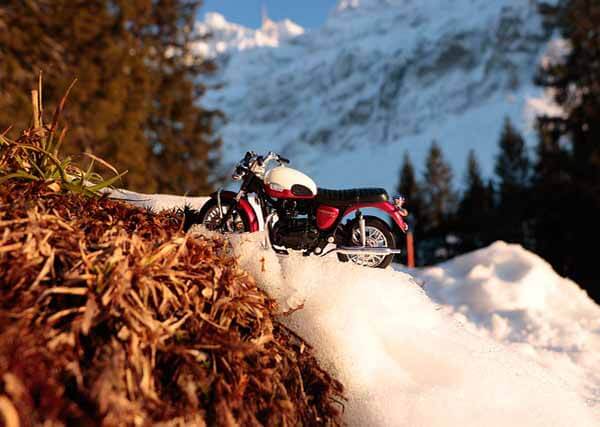Packing in motorcycles for the winter is a little like grandma’s good ol’ medicinal soup recipe, every seasoned biker has this whole routine, and they all sort of “work.” You will hear all kinds of crazy tales, some of which are nothing short of superstition being floated around in biker circles. Equally, there are some useful takeaways from every conversation with a group of riders, and one of the questions that come up iteratively in autumn is can you leave gas in the motorcycle over winter?
Don’t empty your bike’s fuel tank when storing it for the winter. Contrary to common misconception, an empty tank is a den of rust and corrosion and dried-out seals. Keep things wet and fresh with at least 90% fuel and a good dose of stabilizer (typically an ounce of stabilizer goes to up to 2.5 gallons of fuel). Condensate still forms after a while — worst-case scenario — but wet systems are easier to flush out than dried-out crusty ones.
But Do Fuel Stabilizers Treatments Actually Work?
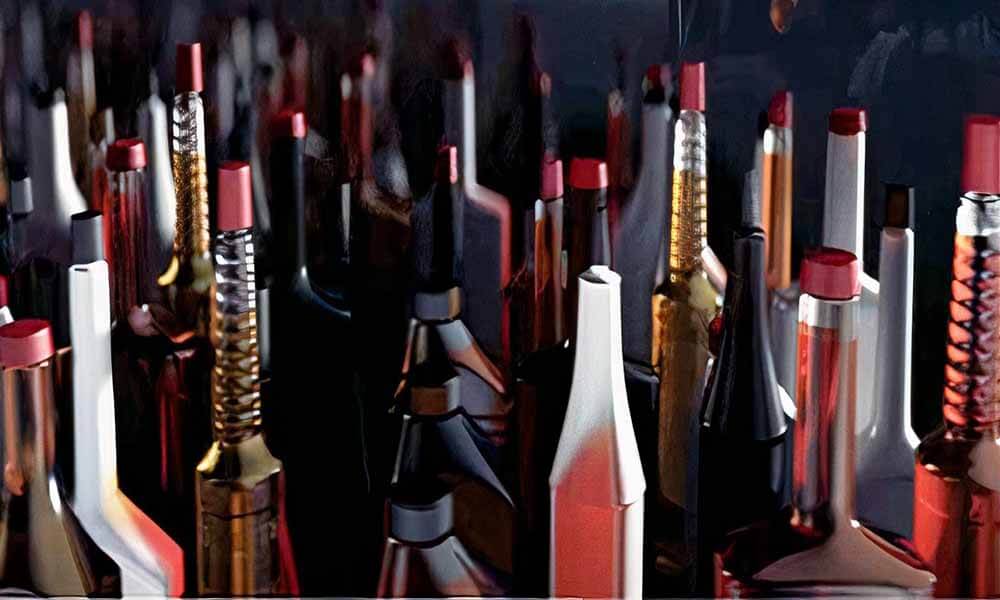
Fossil fuels (like gasoline) remain in the earth’s belly for eons but go bad when abandoned for winter, what an anomaly! Or is it? While gasoline itself is chemically stable and will not readily chemically alter in 10 lifetimes, it is volatile in its refined form, which causes it to vaporize, leaving behind a gummy soup that is problematic for our motorcycles. The plethora of additives to boost fuel performance and what does not help either; metals and minerals oxidize, causing more plumbing and corrosion issues.
For the above reason, regular gasoline is viable for about a month before it starts to go bad. Understanding why this happens is more important than treating the symptoms. The accomplice to every storage crime is ethanol, so if you can fill your tank with ethanol-free gas this fall, do that and don’t worry about the rest. But if you can’t get ethanol-free gas, you can consider some fuel stabilizer but know that not all additives generally help. Some of them are even laced with a little ethanol to make the fuel burn better in the cold.
Come to think of it; if there were some magic potions that made ethanol gas good, it would be included in the boatload of additives already in your fuel.
The only exceptional benefit of fuel stabilizers is oxidation protection of precise passageways and of the fuel itself (gas that oxidizes quickly, goes bad quickly). Additionally, they may reduce gunk and improve combustion; all of which is a do or die come winter. With a good stabilizer, your gas can sit up to 24 months. Be sure to run the bike for a while once you add the treatment to allow it through the injection system pathways.
You May Like: What Happens If I Mistakenly Put Incorrect Gas in My Adventure Bike? Find Out Here!
4 Questions to Answer Before Buying Fuel Stabilizer for Your Motorcycle Winterization
Knowing full well that not all fuel stabilizers are created equal, it is adept that you narrow down your search to the most suitable for your motorcycle’s needs. It all depends on the desired line of action to preserve your fuel and bike.
1. Is It Compatible with My Bike?
Sounds superfluous, but it’s not. Don’t put the horse before the cart, otherwise, it’s a waste of money and time. There are products that work with either petrol, diesel, or both. Also, there are stabilizers for 2-stroke and 4-stroke engines.
2. How Long Is the Fuel Stabilizer Good For?
Most importantly is the duration for which you intend to keep the bike inactive. For shorter periods (a few weeks), you needn’t dump fuel as it might not go bad if it is of premium quality. Stabilizers like Sta-Bil Storage (discussed below) will buy you for up to two years, starting with clean gas and depending on the conditions in your garage. But if you want a shorter term, you can find other less radical approaches like Lucas Oil LUC10020, which can — at the very least — manage to keep the oxidation away.
3. How Easy Is It to Pour/Measure?
These products may contain concentrated harsh chemicals and must be handled with care without making a mess. The potions must be scientifically measured because chemical reactions are involved. A longer neck bottle or dispenser makes a world of difference.
4. What Are the Ingredients in the Fuel Stabilizer Solution?
Sadly, manufacturers will not let us in on their magic product and only list some of the ingredients, but not how exactly the concoction is mixed for obvious reasons. What you want to see is a multipronged plan of action for each of the enemies of idle fuel, including water absorption, volatility, formation of gunk, oxidation, replenishing octane rating, etc.
Common fuel stabilizer ingredients include hydrotreated naphthalene distillate laced with mineral oils to stabilize the fuel by altering chemical composition and some sort of antioxidant to keep the fuel from reacting with the atmosphere. Also, there is almost always that mystery ingredient that makes each solution unique, but don’t take anyone’s word on it. Find some real user reviews relevant to your use case before buying.
Again, fuel stabilizing solutions may contain harsh chemicals and must be handled with care.
Our Top 3 Picks for the Best Motorcycle Fuel Stabilizers
Now let’s take a peek at the highlights and lowlights of the top three most effective fuel stabilizers for motorcycles in the market currently.
1. K100 S+ Fuel Treatment, $16.33 — Best Overall
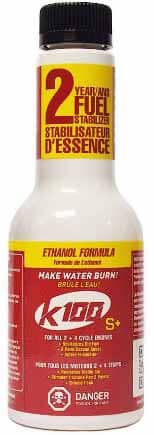
The K100 S+ comes from a family of high-end formulations made from organic compounds and specifically made to cater to water removal, varnish and gum prevention, and fuel stabilization. This product has been praised for adding a gist of lubricity to help protect idle engines from corrosion and fuel from quality and octane rating loss.
We chose the K100 because there is anecdotal evidence that it does remarkably better than the competition for small engines, motorcycles included. It’s a perfect antioxidant.
Pros:
- A +2-octane booster improves performance
- 24 months fuel stabilizer
- Coats water for a flammable mixture
- Averting ethanol phase separation
- Has detergent action on injectors and carbs
Cons:
- Freezes fast and is not the best for prolonged cold storage
2. Sta-Bil Storage Fuel Stabilizer, $5.37 — Runner-Up
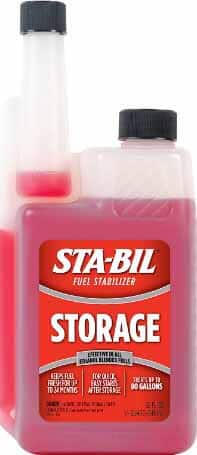
This is another noteworthy choice for the finest gasoline stabilizer and is designed for motorcycles with two and four-stroke gasoline engines. It’s a fantastic choice for long-term storage because it can keep gasoline fresh for up to two years in addition to preventing corrosion, gum, varnish, and residues from the fuel that can clog the fuel pump, carburetor, or engine depending on the conditions in your storage area.
The product’s packaging, which also makes it user-friendly, is one of its greatest features. Because of the way the stabilizer’s container is made, pouring it is simple. You can fill a long-neck squeeze bottle with the precise amount of stabilizer you require. One ounce per 2.5 gallons (9.5 liters) of gasoline is recommended by the manufacturer.
Pros:
- Works great with gasoline engine
- Keeps fuel fresh for up to 24 months
- Prevents corrosion, gum, varnish, and residues
- Easy-to-pour design
- Only 1 oz per 2.5 gallon
Cons:
- Doesn’t lubricate or clean fuel systems
3. IPONE Fuel Stabilizer, $23.09 — Honorable Mention

The phrase you get what you pay for the sort of applies to fuel stabilizers too. The IPONE is a cleverly designed fuel conservation additive that can retain fuel quality for up to two years. The premium brand offers a practical bottle and numerous additional benefits, including antioxidative and anticorrosion properties for both 2-stroke and 4-stroke engines.
IPONE targets small engines, specifically those that use SP 95 or SP 98 gasoline, motorcycles and quads included. A little goes a long way since the 8.45-ounce bottle (250ml) is good for 53 gallons (200 liters) of gasoline, and you only need 25 ml for a 20-liter tank.
Pros:
- 24 months coverage
- Made for gasoline engines
- Practical measurement bottle
- Safe for the environment with or without catalyzed exhaust
Cons:
- Pricey
How to Add Fuel Stabilizer to Your Motorcycle
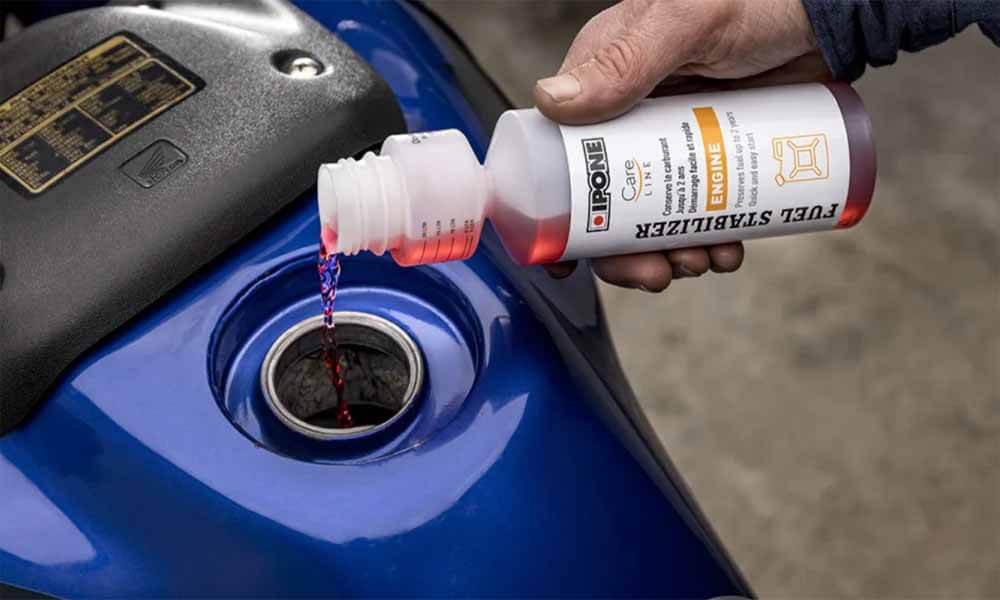
It doesn’t take much to treat the whole fuel supply and safeguard the carburetors or fuel-injection system — just a few ounces for a full tank. Any more than that will cause the gasoline to be so heavily diluted that an explosion and a loss of power are likely to occur.
To prevent condensate from accumulating within the tank throughout the winter, Sta-Bil fuel stabilizer, for instance, advises applying just 1 ounce for up to 2.5 gallons of gas and starting with a nearly full tank.
Slosh the stabilizer in the gas after adding it and run the bike for a few minutes to allow the mixture to flow throughout the gasoline system.
What Happens to the Fuel When It Sits Without a Stabilizer?
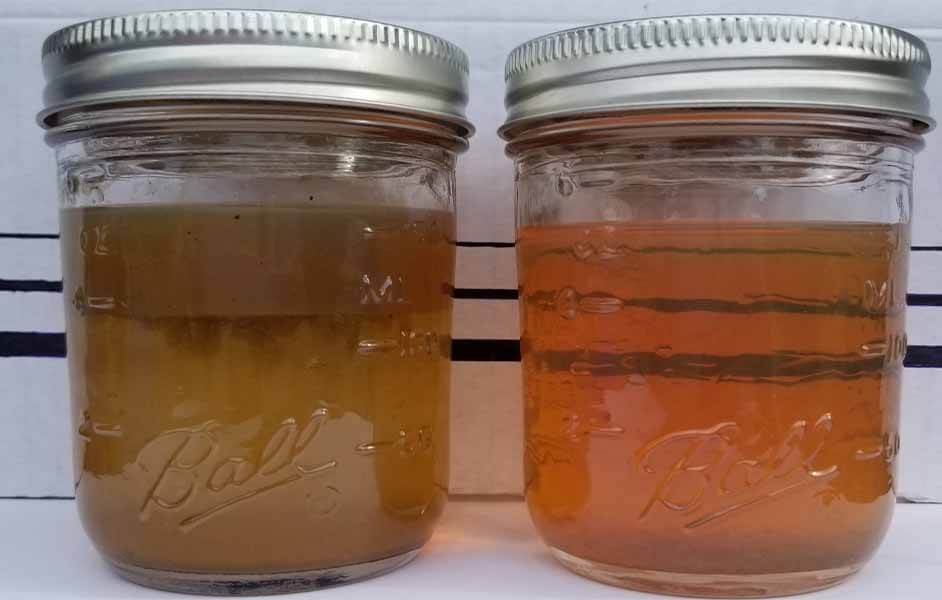
Generally, gasoline is good for about a month before it undergoes too much chemical change, making it unsuitable. For instance, fuel containing ethanol is volatile and hygroscopic i.e., it will naturally evaporate while water is taken in. After some time, the fuel-water mixture will not burn and becomes corrosive while varnish left behind by the evaporating gas creates a residue that clogs up the injection system.
The octane rating will decrease as a result of fuel lingering too long, and even if you manage to start the bike on old fuel, it’s possible that your engine will backfire and perform poorly.
Worst case scenario: you’ll have to thoroughly clean the fuel system since the varnish has already blocked functional components. Fresh gas could remove it, but there truly isn’t any guarantee of that happening without pump failure occurring first.
There is no set amount of time for a bike to sit before it has to be thoroughly cleaned because fuels deteriorate at different rates and the state of your bike as a result might vary. Go straight to cleaning the whole fuel system unless it has been only a couple of weeks. Even if it has been a few months, you can’t rule it out since you never know what to anticipate.
When you drain the fuel, examine the gas’s quality, and peek inside the tank to decide what to do next. You know you have work ahead of you if the fuel is abnormally hazy and you can see varnish within the tank. Your best option is to completely get rid of fuel if it has been languishing for months without a stabilizer.
Are you open to further winterization advice? Read on for pitfalls to properly storing your machine for the winter.
9 Other Mistakes You Should Avoid When Winterizing Your Motorcycle for Long-Term Storage
There is more to storing a bike for a term than just picking a dark and dry location in the garage and abandoning it there and simply hoping it will still run in a few months. Avoiding these mistakes not only preserves the ride but also the rider as it is unsafe to ride a machine battered by time.
Here are 9 mistakes bikers make when storing their motorcycle to be essentially winterproof.
- Don’t Leave it Dirty: A good rub is a useful TLC for your bike to strip away the gunk and debris that can itself chew through metal if left to its own devices.
- Don’t Empty Your Tank and Still Leave It on the Bike: If you plan to store the tank separately you are allowed to store it empty but be sure to throw in some silica packets (water absorbent) to remove any water moisture and choose a dry storage space. Also, shut off the fuel line valve to keep out air, which will invite moisture and condensation inside the tank. Yes, the cap stays on too.
- Don’t Leave Old Oil: Even if your bike won’t be running much, good-quality oil will boost the longevity of internal engine components. Oil reduces volume and contact area for air to act on the engine internals so out with the myth that you should drain your oil to avoid internal damage.
- Never Leave the Sparks Plugs On: Spark plugs are better off stored separately to avoid the rusty terminals from depositing debris inside the chamber. Be sure to cover the holes with a lint-free cloth, duct tape, or other suitable material to keep out air that can cause condensation in the chamber.
- Don’t Leave Your Battery Plugged In: Lithium-Ion batteries as well as the bricky lead-acid counterparts all suffer from parasitic discharge and do require intermittent care to survive the off-season. Although the earlier are much better in that respect, they still appreciate the love and care of a battery tender, which is a device that monitors their voltage and replenishes them automatically.
- Don’t Park Your Motorcycle on Its Tires for Long: Keeping tires idle causes more wear and tear than riding them. Rubber becomes brittle over time and forms flat patches that render tires useless. The optimal pressure to store tires at is around 10 PSI bearing in mind that you might need to inflate to about 15 PSI in hot weather to compensate for the pressure drop in the cold of winter.
- Don’t Leave Your Motorcycle Uncovered: Cover your bike correctly regardless of where you are storing it. A good motorcycle covers your first line of defense against the elements to protect the paint and body of your bike from bugs, dust, and moisture.
- Don’t Leave Your Bike Exposed. Instead, store it in a warm, dark, and dry place. The further from the weather elements you can store your bike the better. If your garage is heated, you should have an easier time. Open spaces (outdoor) are not ideal for storing any vehicle, more so our delicate high-precision-machined two-wheeled torque generators.
- Don’t Start and Only Idle Your Motorcycle: When you start your bike, warm it up for a few minutes, then be sure to ride it for 10-15 kilometers. Idling at a stop is the ideal exercise for how the machine was built to operate.
Before You Even Winterize Your Motorcycle, Don’t Overlook Proper Parking and Storage Area…
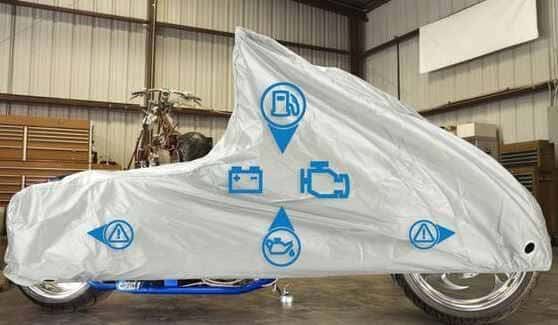
The choice of your motorcycle’s storage place will determine whether it survives or not in the future. Here are your options for indoor and outdoor storage.
Indoor Motorcycle Storage for Colder Months
For added security and peace of mind, store your bike indoors. Options include:
- Garage Storage: Keeping your bike indoors in your garage is a cost-effective and practical method to protect it from the weather and give yourself some piece of mind.
- Prefab Sheds: Retailers provide storage sheds that may be used to house motorcycles. You may avoid taking up room in a garage by storing your bike in a shed.
- Indoor Storage Unit: To keep your bike safe throughout the winter, look for self-storage facilities that provide drive-up, garage-style spaces.
Outdoor Motorcycle Storage Options
As a last resort or maybe in warmer weather, you can store your bike just like your other vehicles.
- Driveway Parking: Parking your bike in your driveway is a simple, cost-effective method to keep an eye on it while saving space.
- Partially Covered Storage Facility: Despite not being totally enclosed, covered storage space at a self-storage facility gives your car a roof, protecting it from the elements.
- Uncovered Storage Unit: You may store your bike for a reasonable price and with ease at many self-storage facilities that provide outdoor parking places in gated, watched areas.
To ensure your motorcycle survives the winter, avoid the above common mistakes owners make, and don’t forget to keep it away from prying eyes in addition to keeping the bike fully charged with fluids, including a full gas tank.
Final Thoughts: Can You Leave Gas in the Motorcycle Over Winter?
Fuel stabilizers make an easy job of keeping your fuel intact through winter. And yes, you can tell if gas has gone bad by just looking at it or smelling it, and so can your little dragon, it will surely sound different!
Gasoline will inevitably go, and just like stale food will give you stomach pains, motorcycles don’t appreciate using bad fuel and will develop a slew of problems. Don’t panic though, as long as you steer clear of the above pitfalls when storing your bike for winter, it should start up without much trouble come spring.
It’s all about investing in your passion or hobby because you realize there is more to owning one and keeping it than meeting the eye. You must think about giving it proper TLC and where you keep it away from thieves and the elements. And in the dead of winter, time apart becomes your enemy.
Information for this article was partially sourced and researched from the following authoritative Government, educational, corporate, and nonprofit organizations:
United states department of transportation
About the Author:
Michael Parrotte started his career in the motorcycle industry by importing AGV Helmets into the North American market. He was then appointed the Vice President of AGV Helmets America, total he worked with AGV Helmets for 25 years. In addition, he functioned as a consultant for KBC Helmets, Vemar Helmets, Suomy Helmets, Marushin Helmets, KYT Helmets, and Sparx Helmets.
In 1985, He is the Founder of AGV Sports Group, Inc. cooperation with AGV Helmets in Valenza Italy
Click here for LinkedIn Profile: https://www.linkedin.com/in/parrotte/
Click here for complete AGV Helmet & AGVSPORT History https://agvsport.com/michael-parrotte
Click here for all AGV Sports Group Social Media information http://agvsport.info/
FM/AL

